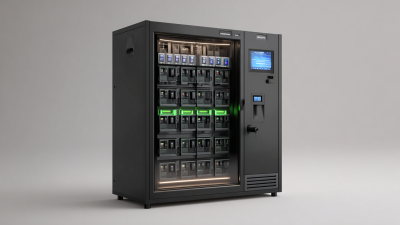Understanding the Essentials of a Physical Key Management System: A Comprehensive Guide
Table of Contents
- Key Concepts in Physical Key Management: Importance and Benefits
- Industry Statistics on Key Loss and Theft: An Eye-Opening Reality
- Best Practices for Implementing a Key Management System
- Evaluating Technology Solutions: Software and Hardware Options
- Compliance and Regulatory Considerations in Key Management
- Future Trends in Key Management Solutions: What to Expect
- FAQS
- Conclusion
- Related Posts
In today's rapidly evolving security landscape, the significance of a robust Physical Key Management System cannot be overstated. According to industry reports, businesses lose millions annually due to inadequate key management practices, with research by the Security Industry Association revealing that 79% of organizations face challenges related to tracking and managing physical keys. This is where companies like Beijing Landwell Electron Technology Co., Ltd. come into play, offering simple and flexible solutions that empower organizations to maintain complete control and oversight of their key usage. By implementing an effective Physical Key Management System, businesses can enhance security protocols, mitigate risks, and streamline operations, ensuring that they not only protect their assets but also maintain compliance with industry standards.

Key Concepts in Physical Key Management: Importance and Benefits
Effective physical key management is essential for organizations to mitigate security risks and enhance operational efficiency. A well-implemented key management system not only safeguards physical assets but also plays a crucial role in compliance with various regulations. According to a report by the Security Industry Association, organizations utilizing sophisticated key management systems can reduce the likelihood of unauthorized access by up to 80%. This statistic underscores the importance of robust practices in managing physical keys.
The benefits of a structured physical key management strategy extend beyond security. A study published in the Security Management Journal revealed that businesses implementing efficient key tracking solutions gained up to 30% improvement in response times during emergencies. Moreover, proper key management reduces the administrative burden associated with lost or misplaced keys, which can cost organizations an average of $5,000 annually in replacement expenses. By prioritizing effective key management, organizations can secure their environments and streamline their operational workflows.
Industry Statistics on Key Loss and Theft: An Eye-Opening Reality
The alarming prevalence of key loss and theft highlights the critical need for robust key management systems in both residential and commercial settings. According to a report by the Association of Physical Security Professionals, nearly 30% of businesses have experienced at least one instance of key loss in the past year, underscoring a widespread vulnerability in physical security protocols. Moreover, a study published by the National Association of Security Companies reveals that nearly 50% of respondents have reported significant financial losses attributable to the unauthorized access gained through lost or stolen keys.
The financial repercussions of key theft are not merely theoretical. A significant incident, such as the burglary at a major retail chain in 2022, resulted in losses exceeding $2 million, primarily due to compromised access control measures. These statistics not only expose the systemic risks organizations face but also reinforce the importance of implementing a comprehensive key management system. By leveraging advanced tracking technologies and adopting best practices for key control, businesses can mitigate the risks associated with key mismanagement, thereby enhancing their overall security posture.
Understanding the Essentials of a Physical Key Management System: A Comprehensive Guide - Industry Statistics on Key Loss and Theft: An Eye-Opening Reality
| Statistic | Value | Year |
|---|---|---|
| Estimated Annual Cost of Key Loss | $2.5 Billion | 2022 |
| Percentage of Businesses Experiencing Key Theft | 30% | 2023 |
| Average Number of Keys Lost per Organization | 100 | 2023 |
| Estimated Recovery Rate of Lost Keys | 15% | 2023 |
| Percentage of Key-Related Security Breaches | 40% | 2022 |
Best Practices for Implementing a Key Management System
Implementing an effective Key Management System (KMS) is critical for organizations to maintain security and operational efficiency. According to a study by the Ponemon Institute, 63% of companies have experienced a security breach due to poor key management practices. To mitigate such risks, businesses should prioritize best practices when establishing their KMS. First, businesses must define a clear key lifecycle management policy, outlining how keys are generated, distributed, rotated, and retired. This structured approach not only reduces human error but also ensures compliance with regulatory standards.

Another vital practice involves regular audits and assessments of the key management process. The 2022 Verizon Data Breach Investigations Report indicates that 45% of data breaches stem from misconfigured security systems, highlighting the importance of periodic evaluations. Organizations should implement automated tools to facilitate these audits, enabling real-time monitoring and alerts for any anomalies in key usage. By adopting these practices, businesses can fortify their defenses against unauthorized access and bolster their overall security posture, ultimately leading to greater trust from clients and stakeholders.
Evaluating Technology Solutions: Software and Hardware Options
When evaluating technology solutions for a Physical Key Management System, it's crucial to consider both software and hardware options that fit the unique needs of your organization. According to recent industry reports, approximately 72% of businesses that implemented integrated technology solutions experienced an increase in operational efficiency. This highlights the importance of selecting systems that not only ensure security but also improve workflow.
Hardware options typically include secure key cabinets and electronic access controls, while software solutions may involve centralized management systems that track key usage and access patterns. As indicated in a 2025 technology industry outlook report, organizations are increasingly investing in smart technology, anticipating a noteworthy growth driven by innovations in security management systems. Furthermore, integrating cloud capabilities can greatly enhance these solutions, enabling real-time tracking and reporting, thus ensuring that management of physical keys is as streamlined and secure as possible.
In the evolving landscape of technology, choosing the right combination of software and hardware is pivotal. With 65% of IT decision-makers stating that cybersecurity measures are critical for their operations, a robust Key Management System plays a vital role in safeguarding both physical assets and sensitive information.
Compliance and Regulatory Considerations in Key Management
In the realm of key management, compliance and regulatory considerations play a pivotal role in ensuring that sensitive information remains protected. Organizations must adhere to various industry-specific regulations, such as the General Data Protection Regulation (GDPR) in Europe or the Health Insurance Portability and Accountability Act (HIPAA) in the United States. These regulations often mandate the implementation of robust physical key management systems that can mitigate risks associated with unauthorized access to sensitive data. Ensuring compliance not only protects customers' and employees' information but also safeguards an organization’s reputation and financial health.
Moreover, regulatory bodies often require documentation and evidence of compliance measures. This includes maintaining detailed logs of key access and usage, which can serve as critical evidence during audits or investigations. Failure to comply with these regulations can result in substantial fines and legal repercussions. Therefore, organizations must invest in a comprehensive key management strategy that incorporates compliance into every aspect, including the selection of physical key management systems, staff training, and ongoing monitoring. By prioritizing compliance, organizations can foster a culture of security and accountability while effectively managing their physical keys.

Future Trends in Key Management Solutions: What to Expect
The future of key management solutions is witnessing rapid evolution, largely driven by technological advancements and shifting market demands. The global AI data center market is projected to surge from $17.73 billion in 2025 to an astonishing $93.6 billion by 2032, reflecting a compound annual growth rate (CAGR) of 26.8%. This tremendous growth is anticipated to influence key management solutions, making them more integral in the protection and management of valuable data assets. As payment methods increasingly transition to contactless transactions, the importance of robust key management systems will only heighten in securing sensitive information.
Moreover, the hardware security module (HSM) market is set to expand significantly, with applications ranging from payment processing to identity verification. By 2032, the HSM market is expected to evolve in response to the burgeoning complexities of data security challenges, including the rise of quantum computing. As traditional encryption systems face threats from quantum technologies, the need for post-quantum cryptographic solutions is becoming paramount. This shift signifies an essential trend for key management systems, emphasizing the importance of evolving encryption methodologies to safeguard user data and privacy in an increasingly digital landscape.
Future Trends in Key Management Solutions
This bar chart illustrates the expected adoption rates of various future trends in key management solutions. As organizations increasingly prioritize security, technologies such as advanced encryption and cloud-based solutions are anticipated to become more prevalent.
FAQS
: Organizations should consider both software and hardware options that fit their unique needs, as well as the potential for increased operational efficiency and security.
Common hardware options include secure key cabinets and electronic access controls.
Software solutions can include centralized management systems that track key usage and access patterns, improving overall management processes.
Integrating cloud capabilities allows for real-time tracking and reporting, streamlining the management of physical keys and enhancing security.
Cybersecurity measures are essential to safeguard physical assets and sensitive information, making a robust Key Management System vital for operations.
Organizations must comply with industry-specific regulations such as the General Data Protection Regulation (GDPR) and the Health Insurance Portability and Accountability Act (HIPAA).
Compliance ensures the protection of sensitive information and helps maintain an organization’s reputation, necessitating investments in robust management systems and practices.
Maintaining detailed logs of key access and usage is critical for demonstrating compliance during audits or investigations and mitigating legal risks.
Non-compliance can lead to substantial fines and legal repercussions for organizations, emphasizing the need for a comprehensive key management strategy.
By prioritizing compliance and incorporating it into all aspects of key management, including system selection and staff training, organizations can create a secure environment.
Conclusion
A Physical Key Management System is essential for organizations looking to maintain control and oversight over their key usage. This comprehensive guide highlights key concepts in physical key management, emphasizing its importance and benefits, particularly in addressing the alarming statistics surrounding key loss and theft. By implementing best practices, businesses can enhance their security measures and reduce the risks associated with unmanaged key access.
Furthermore, the evaluation of technology solutions—both software and hardware—plays a critical role in the effectiveness of a key management system. Compliance with regulatory considerations is also crucial, ensuring that organizations meet necessary standards. As we look to the future, emerging trends in key management solutions will shape how businesses tackle key security, ensuring they remain a step ahead in protecting their assets. At Beijing Landwell Electron Technology Co., Ltd., we provide flexible solutions designed to streamline key management across various environments, empowering organizations to achieve complete oversight of their key usage.
Related Posts
-

Digital Best Practices for Implementing an Effective Key Management System
-

Ultimate Guide to Using a Key Cabinet With Card Reader for Enhanced Security
-

Innovative Examples of Fleet Key Management Box Enhancements for Efficient Operations
-

Ultimate Guide to Choosing a Smart Key Management Cabinet: Key Trends & Industry Insights for Global Buyers
-

Revolutionizing Vehicle Security: The Ultimate Automotive Key Management Cabinet for 2023
-

Choosing the Best Key Locking Organizer for Your Needs a Comprehensive Comparison Guide
Blog Tags:

